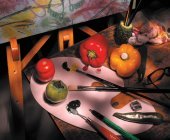|
Use of UV filter in photographyUV filter cuts off unwanted blue cast, which is recorded in an image because of ultra-violet radiation in the natural light. This filter is also known as sky light filter. It is to be simply screw mounted on the lens of a camera. UV radiation is always there in the sunlight. It has a wave length between 370 nm to 390 nm. As it falls outside the visible spectrum, it is not visible to our eyes. However, photographic film and digital image sensor is sensitive to this radiation and it will record this radiation as a blue cast. At higher altitudes, the problem is multiplied as thin atmospheric air fails to absorb this radiation as effectively as it does at sea level.
There are UV-A and UV-B types of ultraviolet radiation. So we need 1A filter for UV-A and 1B filter for UV-B radiation, but for practical use, especially at sea level, any one will work. Be sure of the quality and coating on the filter. A poor quality filter will make the photograph soft and flat, and tonal contrast will reduce. As this filter gives correction on the blue cast, it is a must when we are shooting on a film, as the cast captured because of the radiation is good enough to spoil the overall quality of a photograph, especially if it is shot for a skin tone. We can use a very pale amber or very pale magenta filter to cut the blue cast and improve the skin tone. However, in case of digital photography, digital image sensor is not as sensitive to UV radiation as a film. Whatever blue cast is captured, it can be corrected easily with any photo-editing software. In such case, this filter is not a must, but it is a good protection on the lens for any accidental finger print or dust particle. If you want to capture warm skin tone in a day light, change the white balance setting of the digital camera to 'open shade' or 'over cast'. The skin tone will become richer because of added magenta cast.
|






